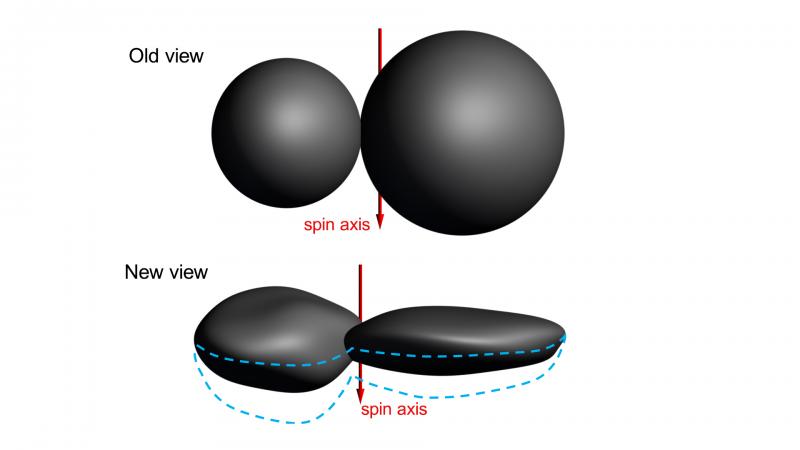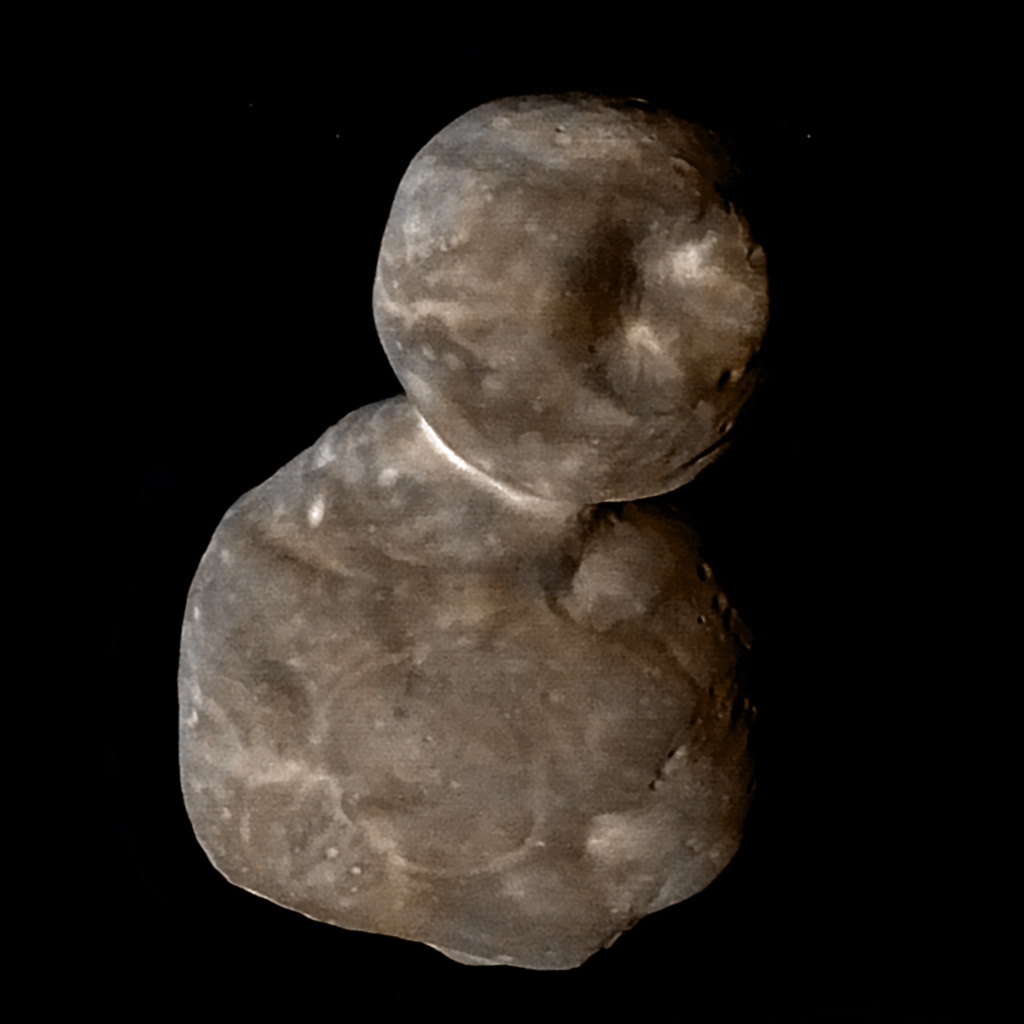It looks like you're using an Ad Blocker.
Please white-list or disable AboveTopSecret.com in your ad-blocking tool.
Thank you.
Some features of ATS will be disabled while you continue to use an ad-blocker.
15
share:
The most detailed images of Ultima Thule -- obtained just minutes before the spacecraft's closest approach at 12:33 a.m. EST on Jan. 1 -- have a resolution of about 110 feet (33 meters) per pixel. Their combination of higher spatial resolution and a favorable viewing geometry offer an unprecedented opportunity to investigate the surface of Ultima Thule, believed to be the most primitive object ever encountered by a spacecraft.
Highest Resolution Image of Ultima Thule
New Horizons Spacecraft Returns Its Sharpest Views of Ultima Thule
"Bullseye!" said New Horizons Principal Investigator Alan Stern, of the Southwest Research Institute (SwRI). "Getting these images required us to know precisely where both tiny Ultima and New Horizons were — moment by moment – as they passed one another at over 32,000 miles per hour in the dim light of the Kuiper Belt, a billion miles beyond Pluto. This was a much tougher observation than anything we had attempted in our 2015 Pluto flyby.
The images are a little disappointing. I was hoping for more detail and different views. I would like to see the other side of UT and a side view showing that it is not round, but more like a pancake.
It is amazing though that the images are as good as they are. The object is very far out in space. There is not much light and the spacecraft was moving at a high rate of speed. Getting a full frame image of UT at close range required all the calculations to be perfect.
edit on 23-2-2019 by LookingAtMars because: (no reason given)
a reply to: LookingAtMars
OK. In a debate with my friend here. Is it a snowman or a peanut?
Either way, this story sort of blew my mind when I first read into it.
OK. In a debate with my friend here. Is it a snowman or a peanut?
Either way, this story sort of blew my mind when I first read into it.
a reply to: strongfp
"Is it a snowman or a peanut?"
None of the above. It is a pancake and a walnut
New Horizons' Departure Images from Ultima Thule - It's a Pancake and Walnut not a Snowman

"Is it a snowman or a peanut?"
None of the above. It is a pancake and a walnut
New Horizons' Departure Images from Ultima Thule - It's a Pancake and Walnut not a Snowman

a reply to: LookingAtMars
Ah, I forgot about that. I remember reading that it was a strange shape and it didn't really make sense to a lot of experts.
I wonder where it came from.
Ah, I forgot about that. I remember reading that it was a strange shape and it didn't really make sense to a lot of experts.
I wonder where it came from.
originally posted by: strongfp
a reply to: LookingAtMars
Ah, I forgot about that. I remember reading that it was a strange shape and it didn't really make sense to a lot of experts.
I wonder where it came from.
It wasn't the shape that was a bit of a mystery; there is nothing terribly unusual abut two lobes that came together like Ultima Thule.
The bit of a mystery was that prior to New Horizons getting close enough to get a good look at the shape, it measured its light curve. Scientists were expecting the light curve to change is it tumbled, because they expected that a likely scenario is that the shape and/or axis of rotation would be such that the light it reflected back to the space probe would change over time.
However, that light curve stayed relatively constant over the time it was being measured. Scientists eventually solved the mystery by learning that the axis of rotation was generally perpendicular to the spacecraft (at least during the time that it was being measured), meaning that as it rotated the same amount of light reflected back.
While it was relatively unlikely that the axis of rotation was what it was, it was not so unlikely to be something that "didn't make sense." Just mildly surprising.
Here's an approximately true-colour image that combines the new image with colour information from an earlier low-rez MVIC image, using
this image by Thomas Appere and rearranging the colours:

The colour MVIC image was taken at near-infrared, red, and blue wavelengths, so I used the red and blue parts, and made an average of the two to create the green channel.

The colour MVIC image was taken at near-infrared, red, and blue wavelengths, so I used the red and blue parts, and made an average of the two to create the green channel.
a reply to: Soylent Green Is People
Thanks for that post! I remember the light curve mystery but never did hear how it resolved.
Thanks for that post! I remember the light curve mystery but never did hear how it resolved.
lets see if there's enough data to venture a guess...
A member posted this image which might be showing us that there are dozens of layers of different kinds of surface materials that lumped together in an ever enlarging body...

i suggest in a million or so years more of accreting material from the Kuiper belt of older Solar Ejecta debris or deep space icy rocks from interstellar space
maybe another Sedna is being developed
originally posted by: strongfpI wonder where it came from.
Ultima and New Horizons ... passed one another at over 32,000 miles per hour in the dim light of the Kuiper Belt, a billion miles beyond Pluto.
A member posted this image which might be showing us that there are dozens of layers of different kinds of surface materials that lumped together in an ever enlarging body...

i suggest in a million or so years more of accreting material from the Kuiper belt of older Solar Ejecta debris or deep space icy rocks from interstellar space
maybe another Sedna is being developed
new topics
-
Chris Christie Wishes Death Upon Trump and Ramaswamy
Politicians & People: 26 minutes ago -
University of Texas Instantly Shuts Down Anti Israel Protests
Education and Media: 2 hours ago -
Any one suspicious of fever promotions events, major investor Goldman Sachs card only.
The Gray Area: 4 hours ago -
God's Righteousness is Greater than Our Wrath
Religion, Faith, And Theology: 9 hours ago
top topics
-
VP's Secret Service agent brawls with other agents at Andrews
Mainstream News: 13 hours ago, 10 flags -
Cats Used as Live Bait to Train Ferocious Pitbulls in Illegal NYC Dogfighting
Social Issues and Civil Unrest: 17 hours ago, 8 flags -
Nearly 70% Of Americans Want Talks To End War In Ukraine
Political Issues: 14 hours ago, 5 flags -
Sunak spinning the sickness figures
Other Current Events: 14 hours ago, 5 flags -
Electrical tricks for saving money
Education and Media: 12 hours ago, 4 flags -
Late Night with the Devil - a really good unusual modern horror film.
Movies: 16 hours ago, 2 flags -
Any one suspicious of fever promotions events, major investor Goldman Sachs card only.
The Gray Area: 4 hours ago, 2 flags -
University of Texas Instantly Shuts Down Anti Israel Protests
Education and Media: 2 hours ago, 1 flags -
God's Righteousness is Greater than Our Wrath
Religion, Faith, And Theology: 9 hours ago, 0 flags -
Chris Christie Wishes Death Upon Trump and Ramaswamy
Politicians & People: 26 minutes ago, 0 flags
active topics
-
Nearly 70% Of Americans Want Talks To End War In Ukraine
Political Issues • 61 • : YourFaceAgain -
University of Texas Instantly Shuts Down Anti Israel Protests
Education and Media • 21 • : FlyersFan -
Chris Christie Wishes Death Upon Trump and Ramaswamy
Politicians & People • 3 • : ImagoDei -
Hate makes for strange bedfellows
US Political Madness • 45 • : YourFaceAgain -
Post A Funny (T&C Friendly) Pic Part IV: The LOL awakens!
General Chit Chat • 7134 • : baddmove -
President BIDEN Vows to Make Americans Pay More Federal Taxes in 2025 - Political Suicide.
2024 Elections • 140 • : ImagoDei -
SETI chief says US has no evidence for alien technology. 'And we never have'
Aliens and UFOs • 62 • : Ophiuchus1 -
Sunak spinning the sickness figures
Other Current Events • 17 • : Ohanka -
So this is what Hamas considers 'freedom fighting' ...
War On Terrorism • 261 • : YourFaceAgain -
Any one suspicious of fever promotions events, major investor Goldman Sachs card only.
The Gray Area • 8 • : mysterioustranger
15

